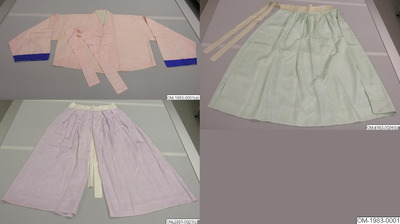| Typ <itemType> |
Objekt/föremål |
| Datering <presTimeLabel> |
1920-tal |
| Plats <presPlaceLabel> |
Asien, Sydkorea, Nordkorea |
| Beskrivning <itemDescription> |
-
Kvinnodräkt i siden: 1 jacka, 2 kjolar.
a) Skär jacka med vitt foder och blå kantband på ärmarna.
b) Ljust grön kjol med vitt liv.
c) Ljust lila (syrenfärgad) kjol med vitt liv.
|
| Förvärvsomständigheter <itemDescription> |
|
| Utställning, del av / planerad <itemDescription> |
|
| Utställning / planerad <itemDescription> |
|
| Land, engelska / ursprung <itemDescription> |
|
| Land, engelska / ursprung <itemDescription> |
|
| Beskrivning, engelska <itemDescription> |
-
Korean traditional attire made from silk:
a) Light pink jacket (jogeori). This light pink-colored jacket made of silk damask is lined with a white gauze and has dark blue cuffs. The seams are hand-st...
Visa hela
Korean traditional attire made from silk:
a) Light pink jacket (jogeori). This light pink-colored jacket made of silk damask is lined with a white gauze and has dark blue cuffs. The seams are hand-stitched. The fabric has a pattern with cloud and dragon motifs. The blue fabric of the cuffs is patterned with chrysanthemum flowers. The border of the collar is bordered with white fabric. The ties of fabric attached to the front of the jacket could be fastened above the chest. This jacket was worn as part of a man’s traditional Korean attire (hanbok), combined with trousers (Korean: baji). Traditional hanbok are still worn in in Korea today during special occasions.
b) Light green skirt (chima). This unlined skirt is made from light green silk fabric and has a white waistband with long strips. The seems are hand-stitched. The green fabric has a weave pattern of flower bouquets and interlinked swastika symbols. This kind of skirts, called chima in Korean, comprise a part of a woman's traditional Korean dress, hanbok. A chima was tied above multiple layers of undergarments, such as under-trousers (see OM-1983-0001c) and underskirts to give the skirt a full, voluminous appearance. Chima were worn in combination with a traditional jacket (Korean: jeogori). Traditional hanbok are still worn in in Korea today during special occasions.
c) Light purple under-trousers. These unlined under-trousers, in Korean called dansokot are made of light purple silk with a flower design and have a white waistband with two strips for securing the trousers at the waist. The seams are hand-stitched. The legs of the trousers are wide, and the fabric pleated into the waistband. The crotch is directly connected to the waistband and split into two parts that are overlapping. The inseams of each leg are open to ca. 40cm above the bottom hem of each trouser leg. Dansokot trousers were worn by women as undergarment below a skirt (Korean: chima). The thin material suggests that they were worn during the summer season.
Stäng
|
| Utställning, monterdel / planerad <itemDescription> |
|
| Utställning, monterdel / planerad <itemDescription> |
|
| Förvärvsomständigheter, engelska <itemDescription> |
|
| Sakord, korea <itemDescription> |
|
| Beskrivning, Korea <itemDescription> |
-
비단으로 만든 전통 의복:
a) 연분홍색 저고리. 손바느질로 만든 저고리로, 겉감은 구름과 용 무늬가 장식된 연분홍색의 비단이고 안감은 흰색의 망사이다. 깃이 흰색이고 소매 끝에는 국화 무늬가 장식된 남색 끝동이 달려 있다. 깃에 달린 고름을 매어 저고리의 앞을 여민 것을 고정한다. 이 저고리는 남성용이며 한국의 전통적인 한복 구성의 일부로 바지와 함께 입...
Visa hela
비단으로 만든 전통 의복:
a) 연분홍색 저고리. 손바느질로 만든 저고리로, 겉감은 구름과 용 무늬가 장식된 연분홍색의 비단이고 안감은 흰색의 망사이다. 깃이 흰색이고 소매 끝에는 국화 무늬가 장식된 남색 끝동이 달려 있다. 깃에 달린 고름을 매어 저고리의 앞을 여민 것을 고정한다. 이 저고리는 남성용이며 한국의 전통적인 한복 구성의 일부로 바지와 함께 입었다.
b) 옅은 초록색 치마. 꽃다발과 만(卍)자 무늬가 직조된 옅은 초록색의 비단을 손바느질 하여 만든 홑치마로 허리말기에 긴 끈 한 쌍이 달려 있다. 이러한 종류의 치마는 여성의 전통 한복 차림의 일부이다. 단속곳을 비롯한 여러 겹의 속옷을 치마 아래에 입음으로써 하의를 부풀려 풍성한 옷맵시를 만들었다. (유물번호 OM-1983-0001c 참고) 치마는 저고리와 함께 입었다.
c) 연보라색 단속곳. 여성들이 치마 아래에 입는 속옷인 단속곳으로, 꽃 무늬가 있는 연보라색 비단으로 손바느질하여 홑옷의 형태로 만들었다. 흰색의 허리말기에 달린 끈 한 쌍을 허리에 매어 바지가 흘러내리지 않게 했다. 바지부리가 넓고 허리 부분에 주름이 잡혀 있다. 가랑이가 허리에 직접 연결되어 있고 두 가랑이는 서로 겹치는 형태이다. 바지통 양쪽 모두 안쪽으로 끝단 위에서부터 40cm 가량 밑이 트여 있다. 얇은 옷감을 사용한 것으로 보아 여름에 입었을 것으로 짐작된다.
Stäng
|
| Datering, korea <itemDescription> |
|
| Titel, engelska <itemDescription> |
|
| Förvärvsomständigheter, koreanska <itemDescription> |
|
| Titel, koreanska <itemDescription> |
|
| Datering, engelska <itemDescription> |
|
| Beskrivning, tidigare <itemDescription> |
-
Kvinnodräkt i siden: 1 jacka, 2 kjolar.
a) Skär jacka med vitt foder och blå kantband på ärmarna.
b) Ljust grön kjol med vitt liv.
c) Ljust lila (syrenfärgad) kjol med vitt liv. Gåva av Nils Fredrik &...
Visa hela
Kvinnodräkt i siden: 1 jacka, 2 kjolar.
a) Skär jacka med vitt foder och blå kantband på ärmarna.
b) Ljust grön kjol med vitt liv.
c) Ljust lila (syrenfärgad) kjol med vitt liv. Gåva av Nils Fredrik & Paul Olof Rudebeck
Stäng
|
| Händelse <context> |
-
Brukad 1920-tal.
-
Ursprung i Sydkorea, Nordkorea, Asien.
-
Förvärvad 1983 av Rudebeck, Nils Fredrik, Rudebeck, Paul Olof.
|
| Material, engelska<itemMaterial> |
- Silk
- Textile
|
| Materialkategori<itemMaterial> |
- Textil
|
| Material, korea<itemMaterial> |
- 사직 絲織
- 견 (絹)
|
| Material<itemMaterial> |
- Siden
- Silke
|
| Nyckelord <itemKeyWord> |
-
Korea
-
OM-1983-0001
-
Textile
-
Östasien
-
사직 絲織
|
| Titel<itemName> |
- Jacka, Kjol
|
| Sakord<itemName> |
- Jacka
- Kjol
|
| Ämne <subject> |
|
| Accessionsnummer <itemNumber> |
|
| Rättigheter för metadata <itemLicense> |

|
| Källa <presOrganization> |
Statens museer för världskultur - Östasiatiska museet |
|
Källa <url>
|
|


 ARTIKLAR I WIKIPEDIA
ARTIKLAR I WIKIPEDIA ARTIKLAR I WIKIDATA
ARTIKLAR I WIKIDATA BILDER I WIKIMEDIA COMMONS
BILDER I WIKIMEDIA COMMONS










